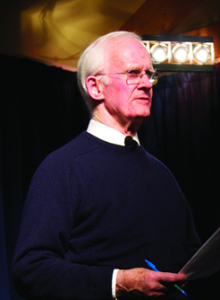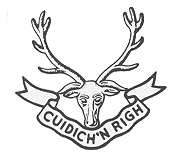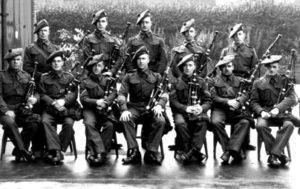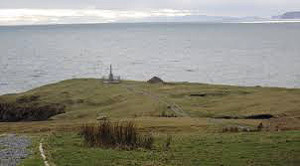 Author Colin Campbell concludes the fourth part of his highly acclaimed series on pipers and pipe music of the First World War with a close look this time at the music of the famous Seaforth Highlanders…
Author Colin Campbell concludes the fourth part of his highly acclaimed series on pipers and pipe music of the First World War with a close look this time at the music of the famous Seaforth Highlanders…
The regiment was initially raised in 1778 as the Seaforth Highlanders and was numbered the 72nd in 1786. The 78th was raised in 1793 by MacKenzie of Seaforth. These separate regiments fought in both the French Revolutionary and Napoleonic Wars. The 72nd took part in the Crimean War, the Indian Mutiny and in the Afghan war of 1878. The 78th went to India in 1816 and fought in the Indian Mutiny. The two were united in the 1881 reforms, and fought in Egypt and South Africa.
This paper was delivered at a concert/ lecture organised by the Scottish Pipers’ Association and sponsored by the National Lottery. Music played by the pipers of the Combined Cadet Force led by P/M Isla Stout:
Cabar Feidh (March) – the Regimental March – motto ‘Deer’s Antlers for Ever’ – the MacKenzie war cry.
Because He Was A Bonny Lad – March Past double time.
High Road To Linton – reel from one of the Mess sets.
Leaving Port Askaig – a 6/8 march by P/M Wm Ross, Scots Guards; served WW1.
Angus McKinnon – MacKinnon was, for 30 years, a member of Edinburgh Police Pipe Band. This 6/8 is by his P/M, Donald Shaw Ramsay. Ramsay served with the HLI in WW2.
The Battle of Waterloo – 4/4 march, traditional.
Seonaidh’s Tune – modern strathspey by Fred Morrison.
Molly Connell – modern strathspey by James Wark.
Kelsey’s Wee Reel – by Iain Symington, modern tune.
Itchy Fingers – a modern reel by Robert Pinkman.
Cuidich ‘n Righ – Serve the King – motto of the MacKenzies of Seaforth; 1st Mess pipes.
Mackenzie Highlanders – fall in.
 The Seaforths in the Great War
The Seaforths in the Great War
At the time of the conflict there were companies stationed all over the north: in Golspie, Dornoch, Bonar Bridge, Brora, Thurso, Wick, Halkirk, Castleton. On average there were two drill stations per company. The regiment saw action in the middle east and in France as part of the 51st Highland Division.
In their ranks was poet E.A. Mackintosh of the 1/5 Seaforths. Here are the words of his poem ‘Before the Summer’:
‘Now the pipes are playing, now the drums are beat,
Now the strong battalions are marching up the street,
But the pipes will not be playing and the bayonets will not shine,
When the regiments I dream of come stumbling down the line.’
Tunes played by Iain Speirs:
2/4 Marches:
1/5th Seaforths Highlanders Welcome to France dates from the end of April/start of May, 1915. Cpl. Herbert Alexander Gamack was born in 1898 in Alloa where his father was an Argylls drill instructor. The son went to France in 1916.
The Seaforth Highlanders March to the Battle of Loos. This battle was designed to take pressure off the French who were bearing the brunt of the war. The battlefield was in the coal fields north of Lille, in exposed and open countryside. In retaliation for the German use of gas, the British deployed it for the first time. The battle was a disaster for Scotland as a disproportionately high percentage of the attacking troops were Scottish – 15th Scottish Division made the most progress until it ran out of leaders and steam. Sgt.MacNiven served in both the 7th and 8th Seaforths. The latter lost 502 men in the first attacking wave at Loos, 23 of them officers.
Three 6/8 Marches composed by Colin Thomson
Thomson was born in Cromarty in 1869 and enlisted in the Seaforths in 1889. He served as a P/M in the Argylls in the Boer War and from 1908-1918 was P/M of the 5th Seaforths.
Mrs John MacDonald of Aultnacealgach. Previously an inn and hunting lodge, Aultnacealgach is now a motel and lies beside Loch Borralan on A837 road from Bonar Bridge, via Lairg. Was Aultnacealgach a stopping place on route marches, or an officers’ howff?
The Assynt Hills and The Elphin Lads. C Company of the 1/5th Seaforths had drill stations at Lairg, Lochinver and Elphin. Killed in WW1, and named on Lochinver Memorial, are two Elphin lads, Donald Campbell and Hugh Fraser, both Seaforths.
Marches, Strathspeys and Reels
Ist Battalion Seaforth Highlanders Farewell to Glencorse
The regiment was stationed at the barracks near Edinburgh from 1887 to 1888. The tune was first published in the Cowal Collection of competition winning tunes in 1920.
R F Current
The following is information supplied by his granddaughter, Irene Whalen: Robert Francis Current was born in June 1885 in Edinburgh and joined the Seaforth Highlanders when he was approximately mid-teens. He was based at various times in Fort George around 1911- 1914, Edinburgh Castle at the time of his marriage in 1908, and Ireland, possibly around 1920. He is thought to have passed the Pipe Majors’ exam in approximately 1921 but never held the post of Pipe Major. He was possibly a tram car conductor in the 1930s but at some point moved to London after his divorce and died there in December 1960. Three of his compositions have been published, but he may have written many more. His grandson, Irene’s brother, has his chanter which was passed down the family, and he in turn learned to play the pipes in his teens through his teacher Tom Speirs, (father of Iain Speirs).
Strathspeys: Major J.O.Hopkinson’s Farewell to Glencorse; P/M David B Mathieson. Mathieson was born in 1883. He rejoined the 1st Seaforths in 1909 as P/M, thence to India, then France where he was wounded and won the Distinguished Conduct Medal.
Reels: Lochness and Longmoor by Colin Thomson. Longmoor was a military training area on Salisbury Plain. Lucarty Hall by David B Mathieson. Luncarty is four miles North of Perth on the A9. Rossie Castle is also by Colin Thomson. Rossie Castle was near Montrose. P/M Thomson served with the 3rdMilitia Bn Seaforths from 1904-1908. There is a tune called 3rd Battalion Seaforth Highlanders Farewell to Montrose dated1905, but no composer name is available. Possibly the regiment camped there. Rossie Castle went on the market in 1913 and although the farms sold, the house did not and fell into disrepair.
Jigs: Bachelor’s Hall by Colin Thomson. This may be from a folk song:
O, bachelor’s hall is bound to be best
Get drunk or stay sober, lay down take your rest,
No woman to scold you, no children to bawl,
So happy is the man that keeps bachelor’s hall.
The Canteen Pot by William Taylor. I’ve no idea about this tune. Seems to me the jug of beer in the barracks’ canteen might be the answer. Resolis by Colin Thomson. Thomson was born at Resolis. There is still a farm there – Resolis Mains – and a farm cottage faces the B9163, between Dingwall and Cromarty, on the north side of the Black Isle.
Pibroch: Lament for the Iolaire by P/M Donald MacLeod

Donald MacLeod was born on Lewis on 14th August, 1916, and had his first piping lessons from his father at the age of four. When, in 1928, John MacDonald came to Stornoway, John Morrison of Assynt House arranged for Donald to have tuition from him. In 1937, Donald joined the Seaforth Highlanders. He went to France and was captured at St. Valery but managed to escape during the forced march to Germany. He became P/M of the Seaforths in 1941. He returned to France in 1944 as Pipe Major of the 7th Battalion and in defiance of an order from his Commanding Officer for his personal safety, played his battalion over the Rhine on its assault crossing. The remainder of his army service was spent mainly in the north and he was stationed at Fort George for some time. He tutored at the Highland Brigade Depot where many young pipers came under his influence. In 1962 he retired and became the joint proprietor of the bagpipe maker Grainger and Campbell in Glasgow. He was renowned as a composer and published six books of light music and one of piobaireachd.
The Iolaire was an Admiralty yacht packed with returning WW1 veterans – mainly sailors who had survived the war. It sailed from Mallaig on 31st December 1918. In the small hours of 1st January and in bad weather conditions, it ran aground on the Beasts of Holm, within sight of home – Stornoway.

Lewis, Harris and Berneray had already lost over 1200 war dead: in the chaos which followed the island lost a further 201 men, drowned, dashed on the rocks, and washed up on the shore in the succeeding days. My mother was a MacIver from Goathill, Stornoway. When I wanted to celebrate Hogmanay she would suppress the notion, and speak, a little, of the Iolaire. Her older sister, many years later, recalled the carts passing Goathill with people taking home their dead relatives.




















I was a piping student of Sgt Donald MacNiven mentioned above as the composer of the Seaforth Highlanders March to the Battle of Loos. After WW 1 he came to Canada & lived in Toronto Ontario where he joined the 48th Highlanders of Canada. He went overseas with them in WW 2. After WW 2 he lived in a small town in Northern Ontario, Canada called Kirkland Lake. He taught many to play of which I was one. He died in 1974 at the age of 80. I played the lament at his funeral & afterwards was given his pipes which his wife Catherine told me he had played throughout WW 1 and WW 2. They are a rather nice set of old Lawries which have been dated as per-WW 1. He continued composing and had several of his compositions appear in Pipe Major John Wilson’s 3rd Collection known as the Centennial Collection which appeared in 1967. Recently, I passed MacNiven’s pipes on to a young friend of mine who is a Pipe Cpl in the Toronto Scottish Regiment & a member of the Pipe Band of Canada’s Ceremonial Guard during the summer months.
James S. Finan
Professor Emeritus
Royal Military College of Canada
The above photograph is of the 1st Battlion, Royal Scots Fusiliers headed by its two remaining pipers in France, August-October 1914.